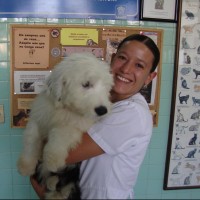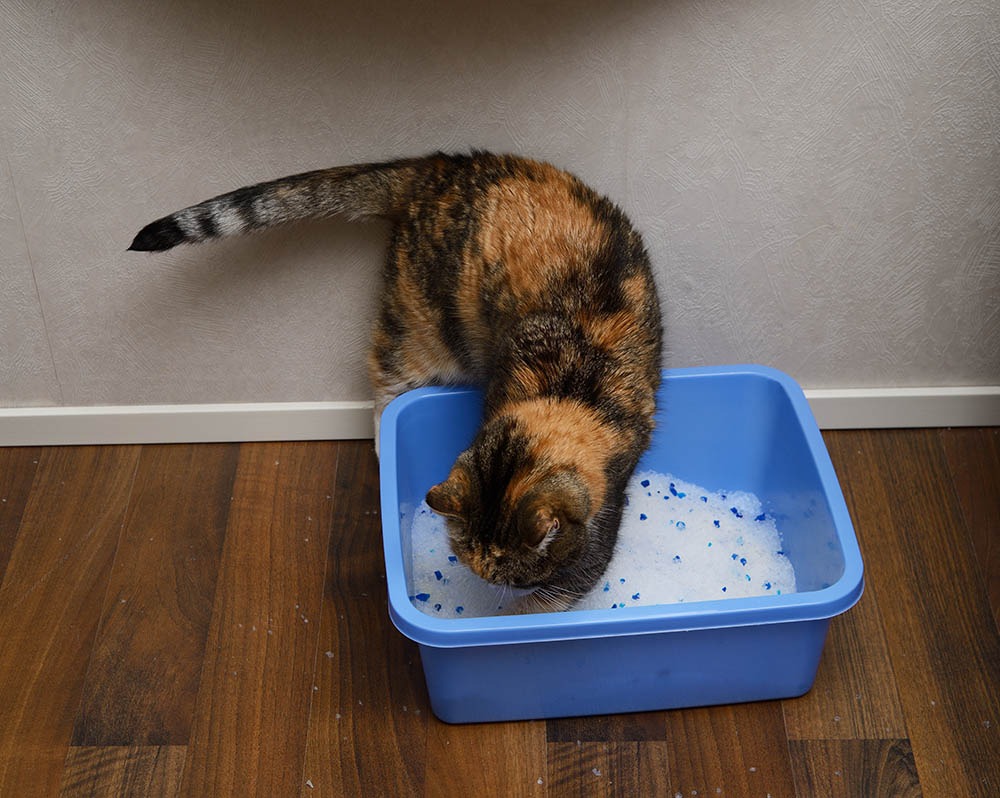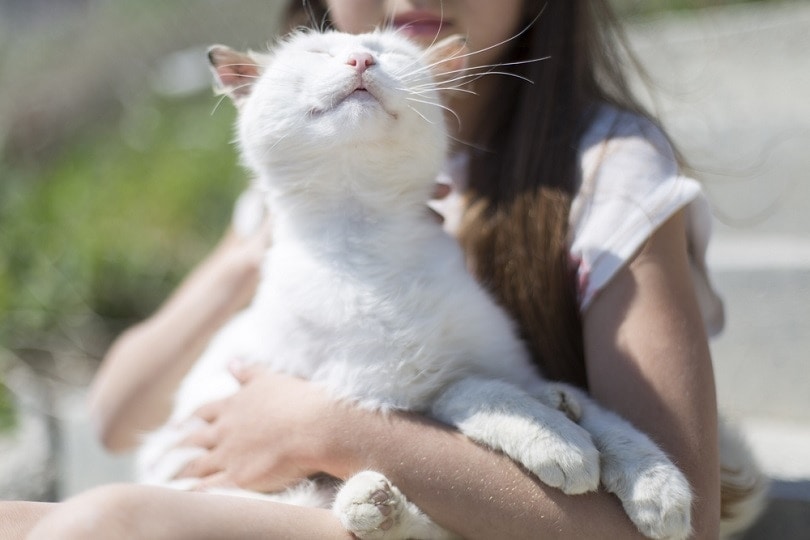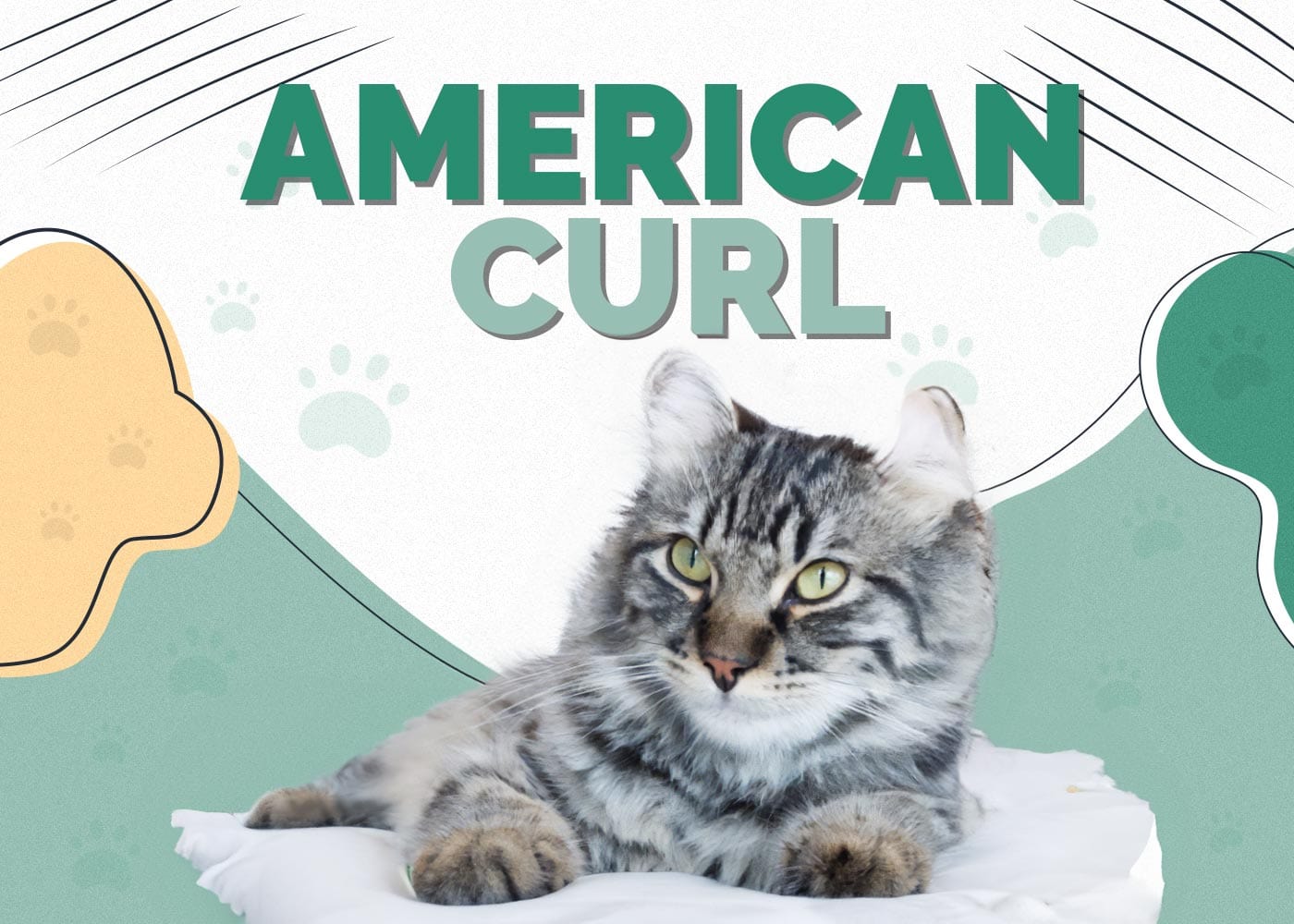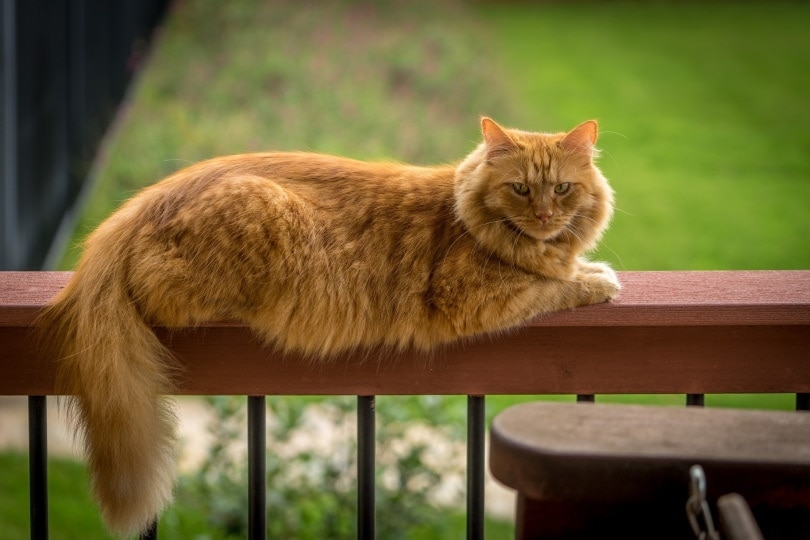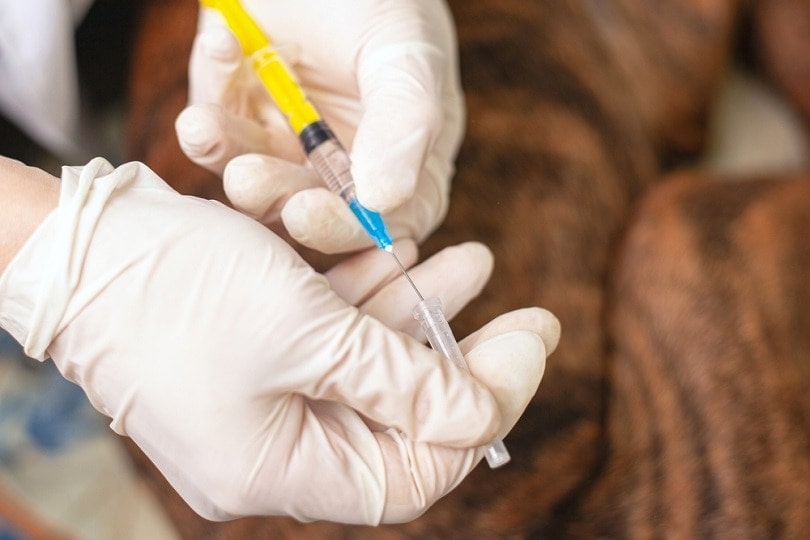How to Determine a Cat’s Body Condition Score: Vet-Reviewed Tips

Updated on

Click to Skip Ahead
Concerned pet parents know weighing their cats is an excellent way to track development between vet visits. With countless differences in body types and fat percentages, weight only offers a tiny glimpse into a cat’s overall well-being.
To fill the gaps and get a better look at your pet’s health, experts developed the body condition score, which is a simple process that owners can perform in the comfort of their homes. Although it can offer immense insights to guide your care, the evaluation is as easy as petting your cat!
You can use body condition scores today to improve your feline’s quality of life. We’ll show you how to determine a cat’s body condition score and explain why it is a valuable tool in optimizing your pet’s routine.
What Is the Body Condition Score?
The body condition score is a subjective, semi-quantitative measuring system to determine whether pets are overweight or underweight, or at the ideal weight. BCS scales are an essential health assessment tool for cats and dogs, but livestock and even zoo animals also undergo regular BCS evaluations.
The BCS works alongside regular weight checks and muscle condition scores to help vets monitor a pet’s growth and recommend adjustments to feeding amounts, exercise routines, and other lifestyle factors contributing to a long, healthy life.
It offers a consistent, standardized method of checking and tracking your cat’s general health and changes in their body. With this, you can consult your vet about any changes you notice in your cat’s body composition.
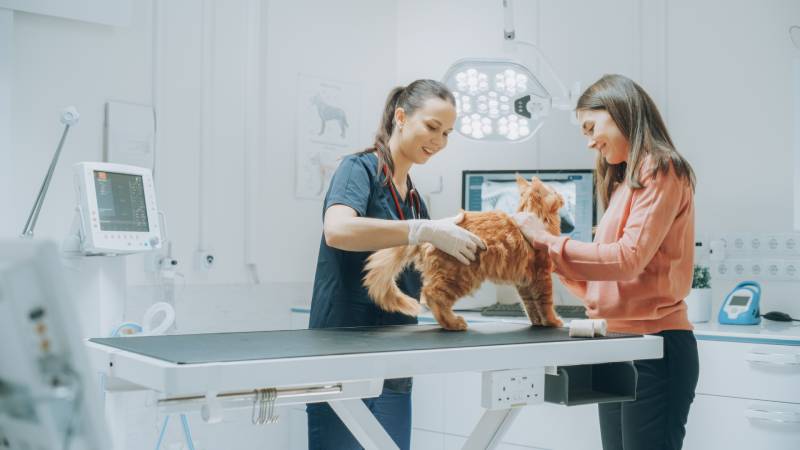
What Does the Body Condition Score Measure?
The BCS combines a visual assessment and palpation, involving touching and feeling the cat’s body.
- The appearance of the ribs, spine, and hips
- Fat around the abdomen, vertebrae, and ribcage
- Amount of abdominal tuck (how high the abdomen tucks up to the body behind the rib cage)
- Overhead visual waistline check
- Amount of fat or muscle
A cat’s body condition score can fall on a five-point or a nine-point scale, but the latter is better for monitoring minor changes. Low scores indicate the cat is too thin, while high numbers mean they are overweight or obese. Ideally, a pet’s score will fall in the mid-range at 3/5 or 5/9.
How to Determine a Cat’s Body Condition Score
The most accurate rating for your cat’s BCS is on a nine-point scale, though some use a five-point grade with half-point intervals. You’ll make visible and tangible observations around three core areas: the ribs, waist, and abdomen. The following are the basic steps to get your cat’s BCS:
- Put your hands on your cat’s sides over the ribcage, applying gentle pressure and moving them back to feel each bone on either side
- Get a bird’s-eye view of your cat’s back and waist to assess the shape
- Check the abdomen from the side to see how it tucks up behind the ribs
- Weigh your cat on a pet scale for an accurate weight reading
Talk to your vet to understand how to measure your cat’s BCS and interpret your results. Although BCS is a reproducible metric, owners often misinterpret or incorrectly estimate their cat’s weight. Factors like long hair on cats and various forms of bias can skew the evaluation, which an expert can mitigate with education and training.
Let’s look at how to measure your cat’s BCS on the nine-point scale.
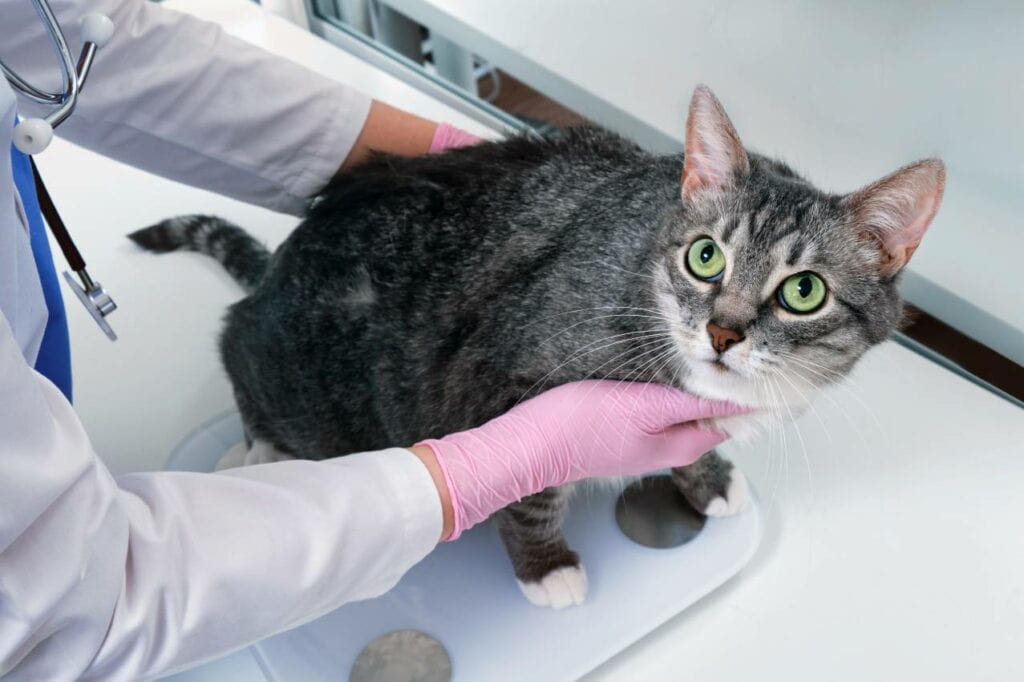
BCS 1: Emaciated
- Ribs easily seen on a short-haired cat
- No fat layers over the ribs or pads on the abdomen
- Significant abdominal tuck
- Vertebrae and hip bones are easy to see and feel
- Extremely narrow waist
BCS 2: Severely Thin
- Ribs are visible on short-haired cats
- No abdominal fat or fat on the rib cage
- Minor loss of muscle mass
- Highly pronounced abdominal tuck
- Obvious waist and lumbar vertebrae
BCS 3: Thin
- Ribs are easy to feel and somewhat visible
- Minimal abdominal and rib cage fat
- Noticeable tummy tuck
- Obvious waistline and lumbar vertebrae
BCS 4: Slightly Thin
- Ribs are not visible but are easy to feel
- Limited abdominal fat pads and rib fat
- Minor abdominal tuck
- Vertebrae and hips are easy to feel but not see
- Obvious waist
BCS 5: Well-Proportioned
- Ribs aren’t visible but noticeable with palpation
- Minor rib fat and minimal abdominal fat
- Slight abdominal tuck
- Obvious but not overly prominent waist
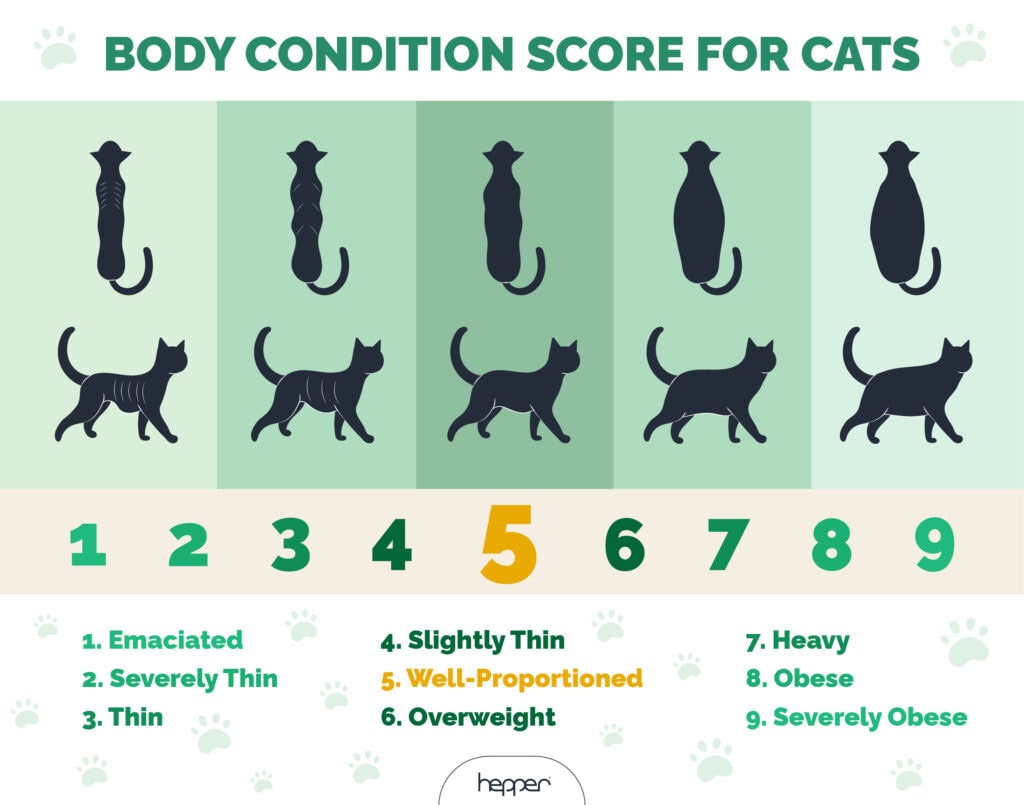
BCS 6: Overweight
- Ribs are not visible but palpable under a slight fat cover
- Limited abdominal fat
- Minor fat covering backbone and hips
- Minimal/no abdominal tuck
- Visible but less defined waistline
BCS 7: Heavy
- Ribs are not easy to feel under moderate fat cover
- Moderate abdominal fat
- Slightly rounded abdomen
- Hips and vertebrae are challenging to feel
- No waistline
BCS 8: Obese
- Ribs are not visible or palpable under a thick fat layer
- Hips and backbone take substantial pressure to feel
- Obvious fatty areas around the lower back
- Swollen abdomen
- Waist isn’t visible
BCS 9: Severely Obese
- Ribs are not palpable under a heavy fat layer
- Fat deposits appear over the lower back
- Distended abdomen with significant fat pads
- Waist isn’t visible
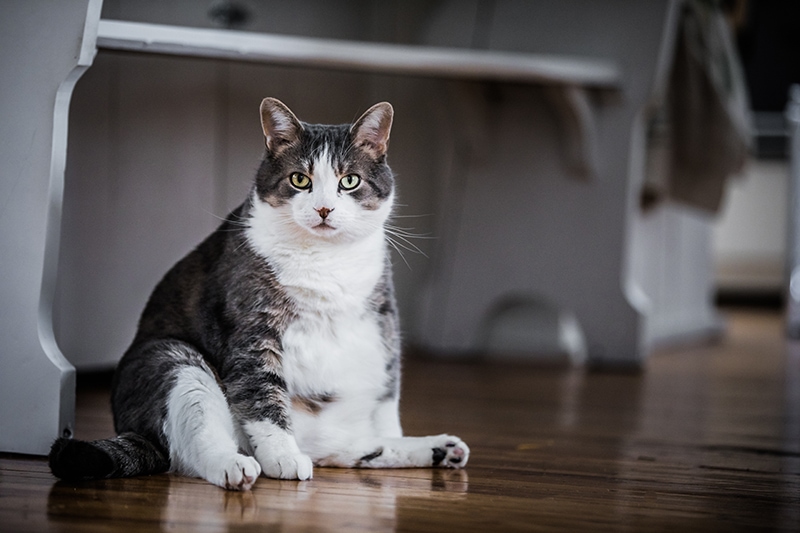
How Often Should I Check My Cat’s BCS?
The schedule to check your cat’s BCS can vary depending on the cat’s needs. A healthy adult cat with no history of weight gain may only need an evaluation two to three times annually. If you have a new cat or one being treated for obesity, behavioral issues, or illness, a monthly body condition score will give better insights into your cat’s progression.
While providing our feline companions with high-quality food is paramount, selecting the right food and water bowl is equally important. The modern yet practical design of our Hepper NomNom Cat Bowl combines cat-catered features, like whisker-friendly shallow dishes and slight elevation, with a contemporary style aimed at protecting your floors from messy eating and drinking. The NomNom is entirely dishwasher safe and was thoughtfully created with your cat’s health and well-being in mind.
Why Is My Cat’s BCS Important?
Nearly every vet utilizes body condition scores alongside weight to assess a cat’s health. Feline obesity is a global issue. Some sources have found that over 61% of cats in the United States are overweight or obese. A cat is overweight when they’re at least 10% over the appropriate weight, while obese cats are more than 20% above their ideal range.
Packing on extra pounds impacts a cat’s daily quality of life and lifespan.
- Diabetes
- Skin diseases
- Heart disease
- Hepatic lipidosis (fatty liver syndrome): Potentially fatal decrease in liver functioning, occurring when an obese cat eats less than usual
- Urinary tract infections
- Lameness
Extreme obesity is likely to lead to a lower life expectancy, but underweight cats are the most at risk of dying early. While body weight is a crucial tool for tracking changes, it doesn’t give elaborate insight into a cat’s body composition and lean-to-fat ratio that determines whether a cat has the proper proportions.
The Effectiveness of BCS
Body composition and body fat percentage are essential measurements that vets use to determine feeding, exercise, and medication routines. The most accurate tool to get those measurements is through dual-energy X-ray absorptiometry, but unfortunately, the procedure isn’t feasible for many pet owners. Not all vets have access to the machinery, the procedure is expensive, and the cats need anesthesia before the scan.
As an alternative, experts created the nine-point BCS scale any vet or owner can use to assess their cat’s body condition. Although it’s a subjective test, studies have shown BCS results accurately reflect body fat percentage. BCS has also been a predictor for cat lifespan, and many studies agree that a score in a slightly overweight grade (BCS 6/9) is associated with the longest average life.
Crucially, BCS can help owners distinguish between a healthy lean cat that’s at a certain weight and a cat with a higher body fat percentage. Identifying these body types is crucial in ensuring that your cat is legitimately healthy, regardless of whether they are at a certain weight.
Final Thoughts
If body weight is the only measurement you track, talk to your vet about determining your cat’s body condition score. Numerous factors, from age to eating habits, can impact a cat’s health. Taking a few moments to assess your pet’s BCS is a crucial first step in making thoughtful adjustments to give them a long and fulfilling life.
Featured Image Credit: Osobystist, Shutterstock
